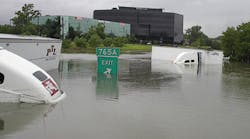As torrential rain overflowed the city’s bayous and backed up storm sewers almost instantaneously, the streets of Houston turned into rivers. The deluge hit TMC particularly hard, as flooding filled underground parking garages, the underground tunnel system that connects many of the facilities, and basements housing critical power supplies, transformers, generators, switches, and other electrical equipment. Allison’s wrath would soon bring new meaning to the term emergency repair work.
It happened more than a year ago, yet the images are still exceptionally clear to those who lived through that unforgettable week. Categorized as the costliest tropical storm in U.S. history, Allison parked itself over southeast Texas from June 5-9, 2001, dumping more than 3 ft of rain (almost 30 in. of which fell over a 48-hr period) on the Houston metro area. The storm stats are startling. Allison left 22 dead and caused almost $5 billion in damage to Harris County alone. In response to the devastation, President Bush declared 28 counties in southeast Texas a federal disaster area. Nineteen more people lost their lives as the storm made its way from the Gulf of Mexico along the southern United States up the East Coast and finally out to sea.
Discovering the disaster
Once Mina could physically get to his facility, he, along with Kent Cavender, director of physical safety, and Mani Palani, director of engineering, quickly established two priorities: maintain emergency power to preserve as much refrigerated research material as possible and pump out the water.
Meanwhile, UT’s medical staff was forced to improvise without electricity, air conditioning, or running water. Without a flashlight, Dr. Annie Philip, M.D., felt her way through the darkness at Memorial Hermann Hospital, searching for a pressure bag she could use to push intravenous fluids into a critically ill patient. Dr. Jose Garcia, M.D., had already been on call for 10 hours when the lights went out. An associate professor of pediatrics at UT-Houston, Garcia raced to keep nearly 80 critically ill infants breathing and warm. Philip and Garcia were among hundreds of health-care professionals and volunteers who worked around the clock to care for patients after water flooded parts of the hospital, crippling the conveniences of modern medicine.
“I have lived through hurricanes in Galveston and other floods in Houston but have never in my life been through anything like this,” says Dr. Kim Connelly Smith, M.D., an associate professor of pediatrics. “The drama was beyond imagination. We hand-ventilated patients for more than 12 hours while awaiting transport, carried them down 10 flights of stairs on backboards, and loaded them onto Black Hawk Army helicopters.”
The water quickly paralyzed TMC, forcing it to close and evacuate many facilities. Total institution losses for UT-Houston and its clinical affiliates (St. Luke’s Hospital, Hermann Hospital, and the Texas Heart Institute) totaled $745.5 million—only 30% of which were covered by insurance.
Within six hours, Hermann Hospital staff had successfully evacuated 540 patients. Mina’s challenge would prove to take much longer. After four days of round-the-clock pumping, his staff had vacuumed more than 10 million gallons of water, which reached a depth of 22 ft, from the medical school building. His department immediately began damage assessment and secured emergency power generation and ventilation equipment to restore vital building systems.
Assessing the damage
When Danny Colwell’s pager went off on June 10, he knew it wasn’t a typical service call. An electrical contractor who also runs a GE Zenith Controls service and warranty repair center, Colwell, president of Colwell Electric in Houston, had existing contracts with some of the facilities. This call came from the staff at Hermann Hospital, asking him to inspect their GE Zenith Controls ATS switches. But he would have to wait five days for the water to recede and debris to be cleared before his staff could assess the damage as well as get safety clearance, given the biohazards involved.
Once environmental health and safety teams had performed all of the necessary safety tests, including air and water sampling, construction crews were allowed in. But they didn’t enter without hesitation, recalls Ken Hodges, president of Houston-based Texan Electric. As the prime electrical contractor for the flood recovery project, Texan Electric powered up distribution panels from generators brought in from off-site. This work escalated into much more, however, so he deployed himself, two project managers, and approximately 25 electricians to the jobsite.
“Think about going down into a basement that’s been under water for days in July in Houston, with no ventilation,” says Hodges. “The humidity is 120%. You’re in a plastic suit, facemask, hard hat, and rubber gloves, and you have to perform really intricate work. It was extreme.”
Many of the contractors described what they saw as a war zone. “It was unbelievable. Switches, generators, and transfer switches—all underwater,” says Colwell, thinking back to the scene in Hermann Hospital’s basement. “It’s one of those things you see on TV, and you know it’s bad. But it’s nothing like going down into these basements where you’ve worked for years to find everything in ruins. You just shake your head and think, ‘How are we going to get this working?’ It’s the worst thing I’ve ever seen.”
Most equipment was permanently damaged; some could be salvaged. Colwell remembers the original goal of getting the hospital back up and running by the following weekend. That plan quickly went away. “We started pulling the guts out of our transfer switches and brought them to our office and ordered $100,000 worth of parts to try and start fixing these things so we could get them back up that week,” he says. “But it was just impossible. I know you have a hospital with thousands of patients that have been moved, but it just can’t be done.”
Carter & Burgess, a national design, management, and operations consulting firm with a full-service office in Houston, was hired as an electrical engineering technical resource to the facilities operations department of UTHSCH to expedite restoration of electrical power to the medical school building. According to the firm, the following systems were not operational at the time of the first walk through: electrical power, emergency electrical power, HVAC, laboratory and fume hood exhaust systems, domestic cold and hot water, compressed air and vacuum systems, fire detection and suppression systems, and basement sanitary and storm sewer systems. The basement contained the incoming service from Houston Light and Power (5kV) as well as several unit substations along with motor control centers, distribution panels, and transformers.
Flood remediation
The facility operations staff, engineering, and environmental health and safety crews worked 14- to 16-hour days without a day off for several weeks. Vacuuming out the water was just the beginning. Crews also had to restore power, pump in dry air to inhibit the growth of potentially dangerous mold, sort through the debris, salvage as much as possible, and inspect the building’s structure. This was especially important because the force of the floodwater was so strong that it destroyed part of the wall between the medical school building and Memorial Hermann’s basements. Not only was time of the essence from a patient care and research standpoint, but school was also starting in August.
As a first step to restore power to the facility, Thomas Roberts, electrical engineer in the energy and engineering services division of facility operations at UTHSCH, remembers having problems with standby power. The facility had one 600kW diesel generator at ground level on an elevated pad that really wasn’t affected by the storm water. However, the automatic transfer switch and some associated distribution equipment were located in the basement. To fix this problem, Roberts disconnected the supply that went down into the basement and ran some temporary power from that generator into the building adjacent to the generator. He also ran some temporary power cables up the stairwell of the medical school building to the second floor where they could connect into the system.
Upon Carter & Burgess’ recommendation, all damaged equipment was removed, disassembled, inspected, and tested, and then reassembled, reinstalled, or replaced. With Texan Electric handling all electrical concerns and Carter & Burgess offering electrical engineering consultation, Roberts hired Cutler-Hammer Engineering Services to remanufacture the main 4,160V service equipment and ECP Tech Services to repair the 480V unit substations.
After his first site visit, Roberts determined the main service gear could be refurbished as far as the enclosure and bussing were concerned. The primary gear would need all new switches and controls. The unit substations consisted of 5kV switches, transformers, and secondary gear. Texan Electric cleaned and tested all equipment and installed new switches, breakers, controls, and gauges where necessary. They considered the remainder of equipment to be beyond repair, so they replaced distribution panels, transformers, and low-voltage panels. Hi-pot testing revealed that the 5kV feeder cable was unreliable, so they pulled out and replaced, tested, and terminated all the cable that was connected to any equipment in the basement. They also tested and replaced most of the 600V feeder and branch wiring.
Because half of UT’s gear was located in the penthouse, the first objective was getting the main service back on, explains Hodges. “We had to repull all of the cable to the penthouse because it’s 5,000V cable that was underwater so you just don’t reuse it,” he says. Working with Cutler-Hammer, Hodges and his crew took apart the main service gear, sent parts out to be repaired, cleaned, or replaced, and actually remanufactured the gear on-site.
Michael Miller, Bud Griffin & Associates, GE Zenith Controls manufacturer’s rep for South Texas in Houston, says manufacturers delivered some of the fastest response time to orders he’s ever seen. For example, Hermann Hospital needed 48 switches; 22 of which were shipped out of stock immediately. The remainder came within two weeks. “Hospitals are priority one when it comes to disaster recovery,” says Miller. “GE Zenith Controls properly prioritized whatever TMC needed, and product requirements were known throughout the company.”
Power was restored to the building in less than three weeks, and most major utilities were restored to the undamaged floors in less than one month. Emergency electrical repairs in excess of $3 million were completed in less than six weeks.
Taking precautions
Despite the fact that no one can effectively plan for an onslaught of water like this (some reports estimated the water rose to almost 40 ft on Houston’s Interstates 10 and 45), UT is making changes to prevent a similar tragedy from happening again. Riding out several hurricanes as facility operations and maintenance manager for Baylor College of Medicine years ago, Tim Koehn’s been sitting on his client’s side of the table for the better part of his career. Now a senior project manager for Cater & Burgess, Koehn says part of the problem with the Great Flood of 2001 can be linked to the increased retirement of experienced personnel. He remembers a similar flood that struck the medical center back in 1976 that caused comparable damage. After this, each institution embarked on its own efforts to install flood walls to help prevent such serious water damage again. “But a lot has happened between 1976 and 2001,” says Koehn. “A lot of the people who knew where the weak points were, where the water came in, what generator flooded, what worked, and what didn’t are gone. It’s been so long since these institutions have seen that level of damage, and most of the people working for the facility now are not as tuned into these issues as their predecessors were 25 years ago.”
That’s why UTHSCH Engineering is working with FEMA to mitigate primary utility infrastructure, including relocating some of the major air handling units, the automatic transfer switch, the 5kV switchgear, unit substations, and other electrical equipment from the basement to the ground and second floors as well as taking steps to ensure the equipment and mechanical rooms in the basement are watertight. They plan to install watertight doors, seals, and panels on all the equipment they can.
“I think after this flood, everybody’s rethinking the traditional philosophy of housing all of their electrical gear in the basement, even though it’s the normal place to put it because the utilities and chilled water outlets come in underground,” says Hodges. “The contingency plans are to start putting everything up so they will not have this problem again.”
That’s just Houston, says Koehn. “It’s like the Harris County flood control guy says, ‘Flood control in Houston is like throwing a cup of water on the middle of a pool table. It just doesn’t go anywhere.’ ”
SIDEBAR: Restoring Power Against Impossible Odds
”It wasn’t there, and then it was,” recalls John Paschal, P. E., thinking back to that unforgettable day last summer when Tropical Storm Allison dumped almost 30 in. of rain over parts of Houston in a 48-hour period, flooding the basement of his 17-story office building with 9 ft of water. Senior Electrical Engineer for a Houston-based international firm and an Editorial Consultant for EC&M, Paschal tells a similar story to that of the medical center’s. He and his coworkers had to get his facility back up and running fast, despite almost impossible odds. Although his building had come through a couple of previous hurricanes unscathed, Paschal says it probably only took about 5 seconds for a tidal wave to flow through the basement after water rose above a doorway in the loading dock area and caved in a 10-in.-thick CMU block wall.
From an emergency repair standpoint, Paschal and his co-workers faced almost complete devastation—all of the mechanical and electrical equipment was ruined. The basement housed the main switchgear, distribution switchgear, central plant with motor control center, and fire alarm system as well as an air compressor system for pneumatic controls, three chillers and associated chiller control panels, life safety switchgear with automatic transfer switch, manual transfer switch, panels for exit lights, egress lighting, exterior entrance lighting, and a host of water and sewer pumps. It also included several air handling units, the telephone service cables, and in-house data system service cables for the company’s world wide hub. After working day and night, Paschal and his engineering team, the company’s IT team and construction specialists, along with two outside contracting firms and 75 of the firm’s electricians, got the facility back up by the end of the fifth day—three months earlier than the building across the street. How did they do it?
First they had to pump the water out and install temporary lighting. They brought in several diesel generators to bring power to the fifth floor cooling units and computer room. “Because heat was a big problem there, the IT team finally removed two exterior building windows and some perimeter glass walls to get some outside air flowing in after temperatures rose to above 120°F,” explains Paschal. While continually wet-vacuuming the basement area, they basically had to gut the space by removing all sheetrock walls, ceiling tiles, ceiling grid, wall studs, and all room contents—this filled about three 20 ft x 12 ft x 7 ft Dumpsters every other hour for three days. They replaced all motors and most appliances, all circuit breakers and switches, the fire pump controller, all motor controllers, and all panelboards. Then they cleaned the main switchgear, and dried out all other electrical items. The team meggered all cables and replaced those that indicated “a short” after dry-out attempts. They realigned all motors and, after dry-out, replaced several main switchgear insulators to make the service equipment megger “clear.” Paschal says just getting the service bus ducts to dry out was a three-day ordeal. They also had to get the air conditioning system back online while the existing chillers were still being renovated, so they brought in a 1,000-ton chiller and 1,500 kVA generator to drive it—operating on this chiller for three months until the permanent HVAC system could be brought back online.
But there were other stumbling blocks along the way that added to the nightmare. As the water immersed the mechanical equipment, oil from the gearboxes floated to the surface. As the revamp team pumped the water out, the oil and grease coated everything. “You talk about something slick. It was almost like walking on ice,” Paschal says. He recalls another unexpected challenge. As the water entered the building, he says it seemed to pick up something that set up a galvanic action on all aluminum lugs, cables, bussing, and springs—destroying all electrical connections and bus surfaces.




